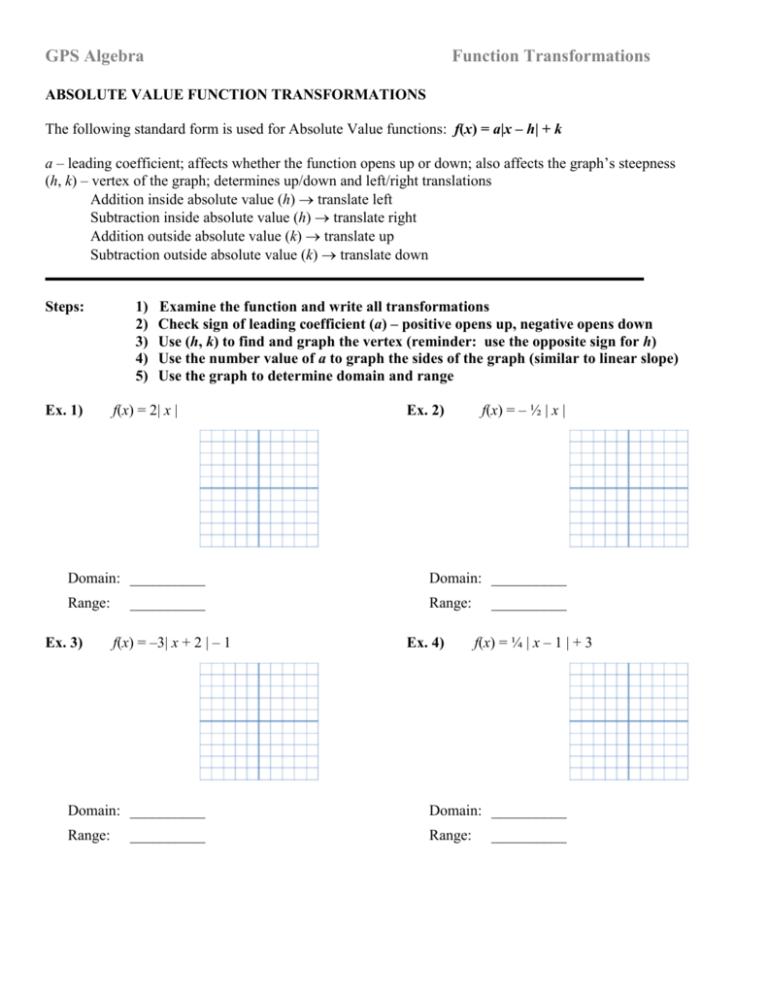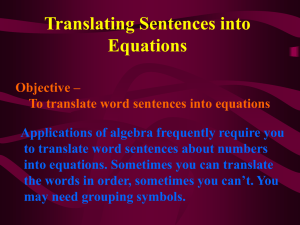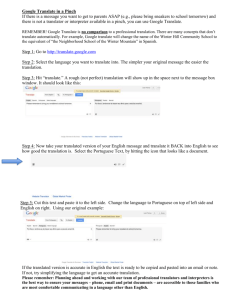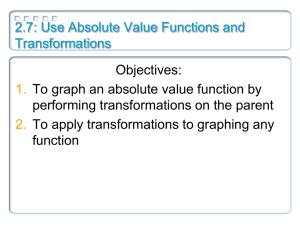Applied Algebra
advertisement

GPS Algebra Function Transformations ABSOLUTE VALUE FUNCTION TRANSFORMATIONS The following standard form is used for Absolute Value functions: f(x) = a|x – h| + k a – leading coefficient; affects whether the function opens up or down; also affects the graph’s steepness (h, k) – vertex of the graph; determines up/down and left/right translations Addition inside absolute value (h) translate left Subtraction inside absolute value (h) translate right Addition outside absolute value (k) translate up Subtraction outside absolute value (k) translate down Steps: 1) 2) 3) 4) 5) Examine the function and write all transformations Check sign of leading coefficient (a) – positive opens up, negative opens down Use (h, k) to find and graph the vertex (reminder: use the opposite sign for h) Use the number value of a to graph the sides of the graph (similar to linear slope) Use the graph to determine domain and range Ex. 1) f(x) = 2| x | Ex. 2) f(x) = – ½ | x | Domain: __________ Domain: __________ Range: Range: Ex. 3) __________ f(x) = –3| x + 2 | – 1 Ex. 4) __________ f(x) = ¼ | x – 1 | + 3 Domain: __________ Domain: __________ Range: Range: __________ __________ GPS Algebra Function Transformations QUADRATIC FUNCTION TRANSFORMATIONS The following standard form is used for Quadratic functions: f(x) = a(x – h)2 + k a – leading coefficient; affects whether the function opens up or down; also affects the graph’s steepness (h, k) – vertex of the graph; determines up/down and left/right translations Addition inside binomial (h) translate left Subtraction inside binomial (h) translate right Addition outside binomial (k) translate up Subtraction outside binomial (k) translate down Steps: 1) 2) 3) 4) 5) Examine the function and write all transformations Check sign of leading coefficient (a) – positive opens up, negative opens down Use (h, k) to find and graph the vertex (reminder: use the opposite sign for h) Use the number value of a to graph the curved sides of the parabola Use the graph to determine domain and range Ex. 1) f(x) = 2(x)2 Ex. 2) f(x) = – ½ (x)2 Domain: __________ Domain: __________ Range: Range: Ex. 3) __________ f(x) = –3(x + 2)2 – 1 Ex. 4) __________ f(x) = ¼ (x – 1)2 + 3 Domain: __________ Domain: __________ Range: Range: __________ __________ GPS Algebra Function Transformations CUBIC FUNCTION TRANSFORMATIONS The following standard form is used for Cubic functions: f(x) = a(x – h)3 + k a – leading coefficient; affects whether the function opens up or down; also affects the graph’s steepness (h, k) – vertex of the graph; determines up/down and left/right translations Addition inside binomial (h) translate left Subtraction inside binomial (h) translate right Addition outside binomial (k) translate up Subtraction outside binomial (k) translate down Steps: 1) 2) 3) 4) 5) Examine the function and write all transformations Check sign of leading coefficient (a) – positive opens up, negative opens down Use (h, k) to find and graph the vertex (reminder: use the opposite sign for h) Use the number value of a to graph the curved sides of the curve Use the graph to determine domain and range Ex. 1) f(x) = 2(x)3 Ex. 2) f(x) = – ½ (x)3 Domain: __________ Domain: __________ Range: Range: Ex. 3) __________ f(x) = –3(x + 2)3 – 1 Ex. 4) __________ f(x) = ¼ (x – 1)3 + 3 Domain: __________ Domain: __________ Range: Range: __________ __________ GPS Algebra Function Transformations SQUARE ROOT FUNCTION TRANSFORMATIONS The following standard form is used for Square Root functions: f(x) = a√(𝒙 – 𝒉) + k a – leading coefficient; affects whether the function opens up and over or down and over; also affects the graph’s steepness (h, k) – vertex of the graph; determines up/down and left/right translations Addition inside radical (h) translate left Subtraction inside radical (h) translate right Addition outside radical (k) translate up Subtraction outside radical (k) translate down Steps: Ex. 1) 1) Examine the function and write all transformations 2) Check sign of leading coefficient (a) – positive opens up and over, negative opens down and over 3) Use (h, k) to find and graph the endpoint (reminder: use the opposite sign for h) 4) Use the number value of a to graph the curved sides of the parabola 5) Use the graph to determine domain and range f(x) = 2√𝑥 Ex. 2) f(x) = – ½ √𝑥 Domain: __________ Domain: __________ Range: Range: Ex. 3) __________ f(x) = –3√𝑥 + 2 – 1 Ex. 4) __________ f(x) = ¼ √𝑥 – 1 + 3 Domain: __________ Domain: __________ Range: Range: __________ __________ GPS Algebra Function Transformations RATIONAL FUNCTION TRANSFORMATIONS 𝒂 The following standard form is used for Rational functions: f(x) = 𝒙−𝒉 + 𝒌 a – coefficient in numerator; affects whether the function is reflected down; also affects the graph’s steepness (h, k) – center of the graph; determines up/down and left/right translations Addition in denominator (h) translate left Subtraction in denominator (h) translate right Addition in denominator (k) translate up Subtraction in denominator (k) translate down Steps: Ex. 1) 1) Examine the function and write all transformations 2) Check sign of leading coefficient (a) – positive keeps parent function shape and negative is reflected down 3) Use (h, k) to find and locate the center (reminder: use the opposite sign for h) 4) Extend up/down and left/right from the center for asymptotes 5) Locate anchor points and sketch graph 6) Use the graph to determine domain and range 1 f(x) = 𝑥−2 Ex. 2) 1 f(x) = 𝑥 − 2 Domain: __________ Domain: __________ Range: Range: Ex. 3) __________ 1 f(x) = – 𝑥+2 Ex. 4) __________ 1 f(x) = 𝑥−1 + 2 Domain: __________ Domain: __________ Range: Range: __________ __________








